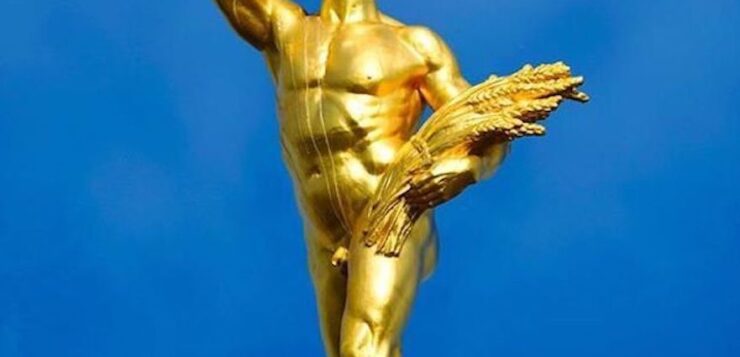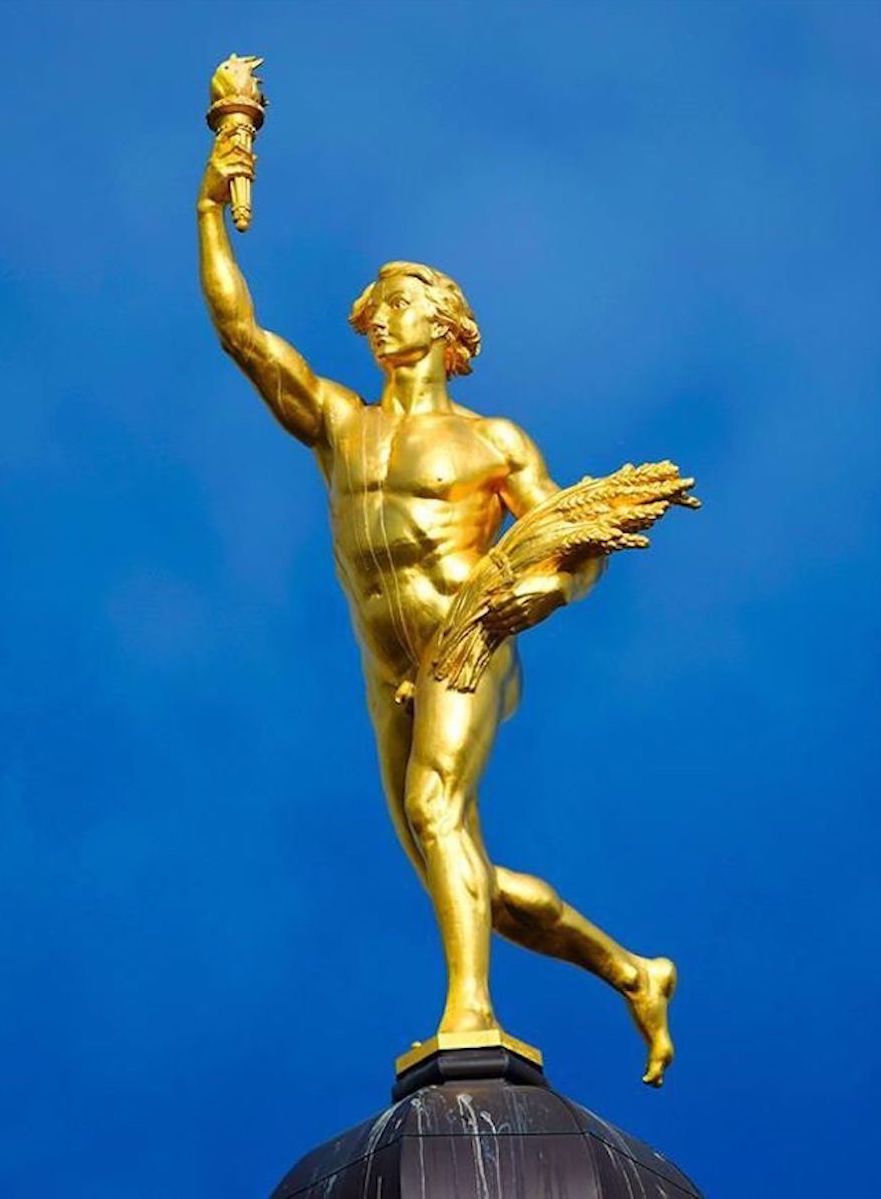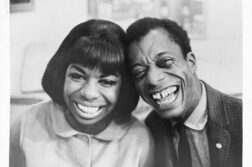PURPLE CITY
Directed by Noam Gonick and Michael Walker
Video Vindaloo
OFFICIALLY CHRISTENED Eternal Youth but generally known to natives of Winnipeg by its nickname “The Golden Boy,” the statue high above the dome of the Manitoba Legislative Building seems to have been inspired by Giambologna’s Flying Mercury in Florence’s Bargello. Visible for miles around, shining gold from having been recently taken down for a cleaning, it would surely freak out the folks of Republican Florida. DeSantis would have it banned or burned.
A new short documentary on the statue and its site premiered in March at Montréal’s international film festival and is now making the rounds of film festivals around the continent. The queer filmmakers Noam Gonick and Michael Walker—who also stars as the Golden Boy incarnate—and he does live up to it!—live in a rent-controlled apartment across the grounds from the statue. They say the idea for the film came to them on their first date, after watching James Bidgood’s Pink Narcissus and going out to an exhibit of pieces from Berlin’s Pergamon Museum. Noam noted the similarity in build between his potential new boyfriend and a Dionysus in the exhibit. Before they left, and while the guards weren’t looking, they gave a 2,500-year-old stone Zeus a full kiss on the lips.
Beauty is truth, truth beauty—the Keatsian credo finds resonance in this film. Nature is art, the film boldly claims. Nature is queer. The film’s title Purple City refers to a teenage acid ritual. Kids would stare into the orange klieg lights illuminating the Golden Boy until the retina burned and the city turned a psychedelic mauve. In the film, three characters drop acid and embark us on a magical mystery tour, into an underworld of lost souls, an oneiric journey charged with secret wisdom and sacred ecstasy. The montage of scenes follows the logic of rapturous trance. It begins in snowy winter, the legislative grounds festooned in a Milky Way of Christmas lights. Forward to a meadow in the heat of summer with rustic Anatolian goat herders in straw hats.
All the while, the voice-over narrator speaks in solemn tones, as if reading from a sacred text, commenting on The Golden Boy’s mythical dimension. Gardet meant his statue to represent Hermes (or the Roman Mercury), messenger to the gods. Hermes was a lot of things in Greek mythology—god of shepherds, of athletes, of commerce (hence the sheath of wheat he bears). He was also known as the god of magic, the supreme Trickster. It is significant that Gardet worked from live models that he found on the street—liverymen, pickpockets, and so on. Gardet seemed to go in for curly hair, bulging biceps and legs, an angelic face. The film illustrates the tie between Paris and the middle-western Canadian city, originally a French outpost, having the models do a cute little can-can.
The voice-over also provides information on the historical circumstances of the statue’s creation and transportation. The Golden Boy recently celebrated its 100th anniversary. It was forged in Paris, often coated in explosive dust from World War I bombs that kept hitting the foundry. Completed in 1918—hence the music of Erik Satie playing in the background—it was lowered into the hold of a merchant marine vessel and shipped across the Atlantic while German torpedo boats were still scouring the deep, as the film illustrates via animation. It was dragged by rail via Chicago to its final lap up the Seine River to Winnipeg and erected atop the beaux-arts neoclassical dome of the province’s legislative building, where it still stands today. (Incidentally, the building’s interior is striking for its Freemason-inspired ancient Egyptian imagery.)
The Golden Boy stands as a unique focal point of ancient Greek and local Indigenous cultures. Hermaphroditus is actually a nudge and a wink at the fact that it was beneath the statue that the term “Two Spirit” was coined in 1990 by lesbian Ojibwa activist-educator Myra Laramee after she had a vision while overnighting in a protester’s teepee outside the Legislative Building. “Two Spirit” was subsequently adopted worldwide after the 3rd Annual Gathering of Native American Gays and Lesbians at Beausejour, Manitoba. Worthy of note is that the film is dedicated to the actor who plays the oracle (doubling also as a hustler smoking beneath the statue), Erryn Schau (1994–2020), an Indigenous trans woman who died of an overdose during the Covid pandemic.
Over the years, The Golden Boy has been bound up with plenty of social and political controversy, and not just the predictable periodic outcries of people offended by sculpted genitalia. The Métis rebel Louis Riel, who was hanged in 1885 for fighting British imperialism, once declared the place a temple of New Jerusalem. On ground level on Canada Day (July 1st) in 2022, two actual queens were toppled and beheaded, Elizabeth II and Victoria, by Indigenous activists responding to the discovery of mass graves at residential schools. Queen Victoria’s crown was removed and her “head” tossed into the river that runs behind the legislative grounds (only to be discovered by a kayaker). Her crown is still missing. Both statues are now in storage, out of the public view, pending a decision by the government concerning their future. For decades the site was known as The Hill, a place of gay cruising and hustling much like Lafayette Park in NYC or Griffith Park in L.A. Indeed, every large North American city had its park, its “tunnels and labyrinths, shrubbery, feathery fens that led us into the altars of our imagination,” as Frank Browning put it in A Queer Geography.
The surrealistic cinematography is characteristic of the independent Winnipeg Film Group and Guy Maddin, director of at least two underground classics, The Saddest Music in the World (2003), starring Isabella Rossellini, and My Winnipeg (2007), which features Ann Savage. Laden with the symbolism of the four elements, Purple City nevertheless maintains a camp humor. A librarian has sex with a Liberian. The Assiniboine River alongside The Hill gets renamed Ass in a Boy. “We sleep in the light of the Golden Boy’s ass,” the narrator soberly explains. And Winnipeg is declared “the hermetic capital of the universe.”
David Tacium, PhD, based in Montréal, is the author of the novel Taking Down the Golden Boy (2018).







